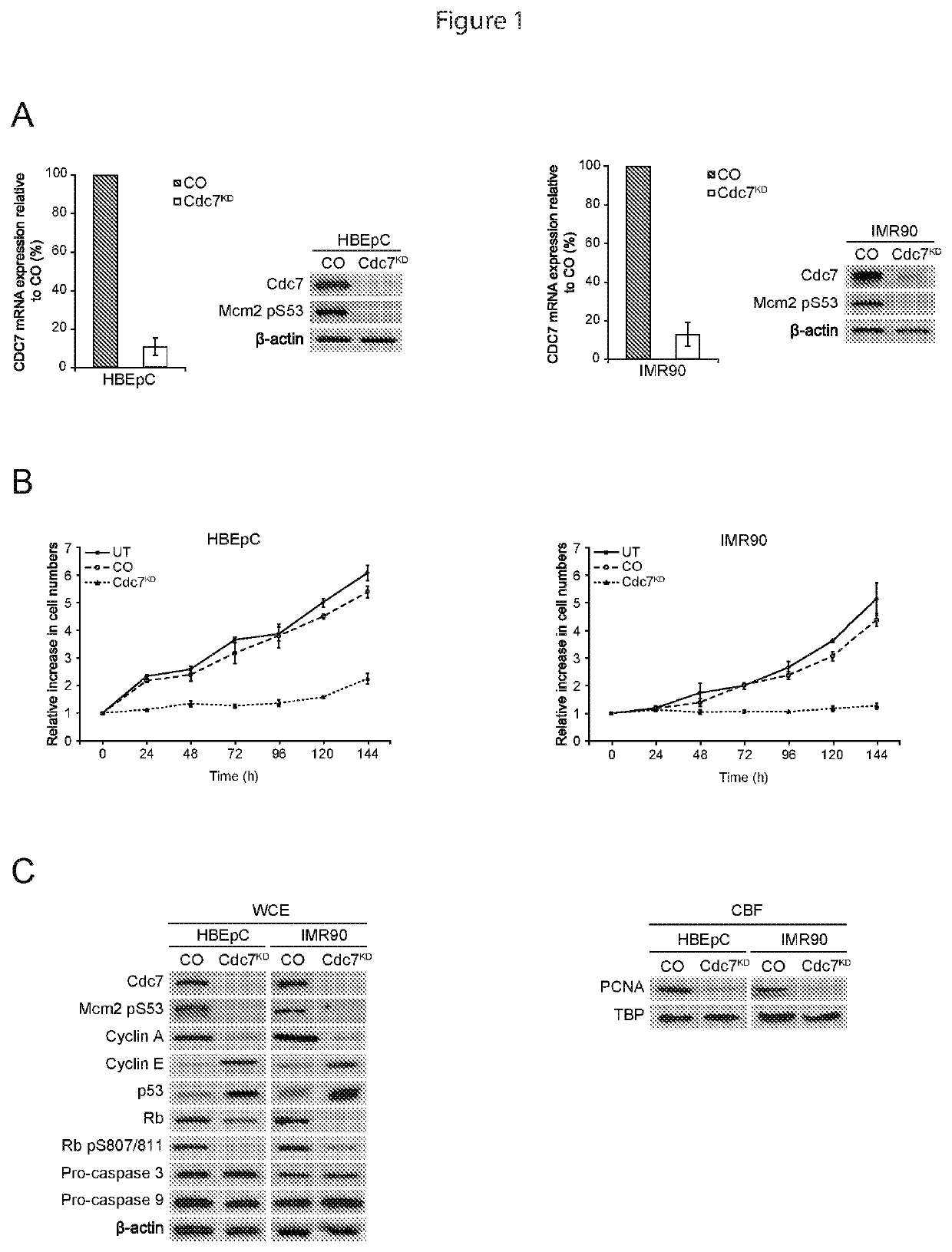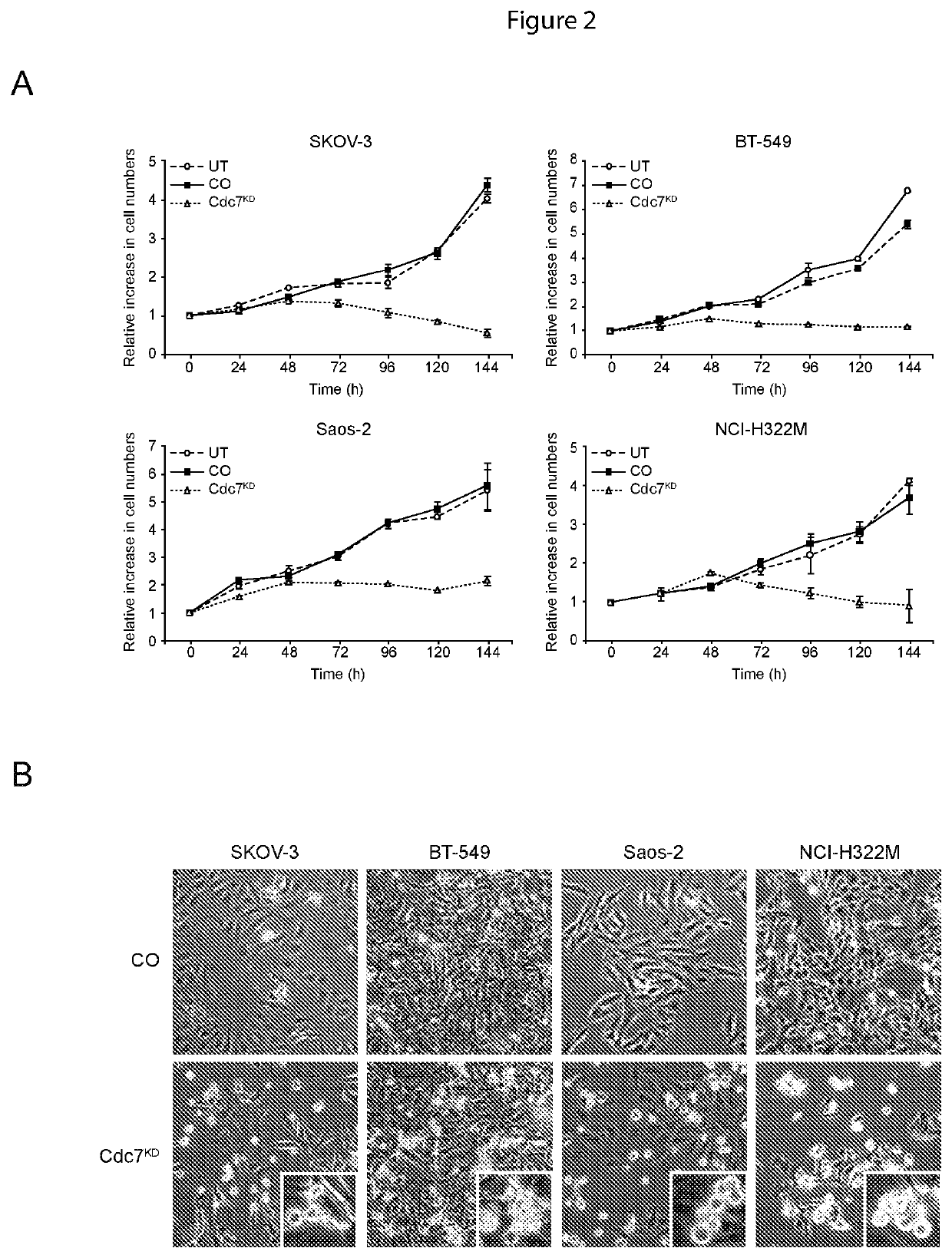Therapeutic combination
a combination and therapy technology, applied in the field of therapeutic combination, can solve the problems of high turnover of normal tissues, abortive s phase and apoptosis cell death, fork stalling/collapse, etc., and achieve the effects of enhancing cancer-cell specific killing, low toxicity, and high turnover
- Summary
- Abstract
- Description
- Claims
- Application Information
AI Technical Summary
Benefits of technology
Problems solved by technology
Method used
Image
Examples
example 1
[0063]CDC7 Knockdown Causes Cell Cycle Arrest in Primary Human Mesenchymal and Epithelial Cells
[0064]As discussed above, it has been reported that Cdc7 depletion in primary cells leads to a G1 cell cycle arrest, pointing towards an origin activation checkpoint. This was investigated in two different primary untransformed cell types to ensure that this checkpoint is conserved.
[0065]IMR90 mesenchymal diploid fibroblasts (CCL-186, ATCC) were cultured in Dulbecco's Modified Eagle's medium (31966, Invitrogen) supplemented with 10% Fetal Bovine Serum (FBS) (10270-106, Invitrogen). HBEpC bronchial epithelial primary cells (ECACC, 502-05a) were cultured in Bronchial Epithelial Cell Serum Free growth medium (Ser. No. 06 / 091,518, ECACC).
[0066]Cells were then transfected with CDC7-siRNA to inhibit CDC7 expression. Specifically, CDC7 expression was inhibited with custom double-stranded RNA oligos (5′-GCUCAGCAGGAAAGGUGUUUU-3′ (SEQ ID NO 1) and 5′-AACACCUUUCCUGCUGAGCUU-3′ (SEQ ID NO 2) Thermo Sci...
example 2
[0079]Loss of Function of p53 Disables the Origin Activation Checkpoint in Transformed Cells
[0080]A dependency on p53 for Cdc7-depletion induced cell cycle arrest has been shown for human dermal and lung fibroblasts, and mammary epithelial cells. The present observation that p53 is also stabilized in bronchial epithelial cells arrested by Cdc7 depletion (FIG. 1C) is consistent with an active role for p53 in the underlying cell cycle checkpoint that is conserved between different primary cell lines of mesenchymal and epithelial origin. To confirm the p53 dependency of this checkpoint in both the primary cell lines used in the present study, RNAi was used to inhibit p53 expression in HBEpC and IMR90 cells previously arrested by Cdc7 depletion.
[0081]For double-transfection with CDC7 and p53 siRNAs (p53 specific duplex, sense 5′-GGA AGA CUC CAG UGG UAA UUU-3′ (SEQ ID NO 7) and antisense 5′-AUU ACC ACU GGA GUC UUC CUU-3′ (SEQ ID NO 8) and ON-TARGETplus SMARTpool TP53 L-003329-00 [Thermo ...
example 3
[0087]CDC7 Knockdown Enhances Paclitaxel Toxicity in Transformed Cells
[0088]Since CDC7 depletion causes an abortive S phase and apoptotic cell death in cancer cells (FIG. 2), the applicants postulated that pharmacological Cdc7 inhibitors could be used not only as a single agent therapeutic but also in combination with existing chemotherapy, such as the potent anti-mitotic paclitaxel. We therefore tested the hypothesis that CDC7 knockdown in combination with paclitaxel would increase cancer cell killing compared with single agent treatment.
[0089]SKOV-3, BT-549, Saos-2 and NCI-H322M cells as described in Example 2 were cultured for 24 hours with increasing paclitaxel concentrations (50 nM-5 mM) to determine a concentration that resulted in a similar level of cancer cell killing compared to treatment with CDC7-siRNA after 72 hours (FIG. 3D). Next, SKOV-3, BT-549, Saos-2 and NCI-H322M cells were transfected with CDC7-siRNA or control-siRNA 48 hours prior to treatment with 100 nM (BT-549...
PUM
| Property | Measurement | Unit |
|---|---|---|
| Time | aaaaa | aaaaa |
| Time | aaaaa | aaaaa |
| Cytotoxicity | aaaaa | aaaaa |
Abstract
Description
Claims
Application Information
 Login to View More
Login to View More - R&D
- Intellectual Property
- Life Sciences
- Materials
- Tech Scout
- Unparalleled Data Quality
- Higher Quality Content
- 60% Fewer Hallucinations
Browse by: Latest US Patents, China's latest patents, Technical Efficacy Thesaurus, Application Domain, Technology Topic, Popular Technical Reports.
© 2025 PatSnap. All rights reserved.Legal|Privacy policy|Modern Slavery Act Transparency Statement|Sitemap|About US| Contact US: help@patsnap.com



